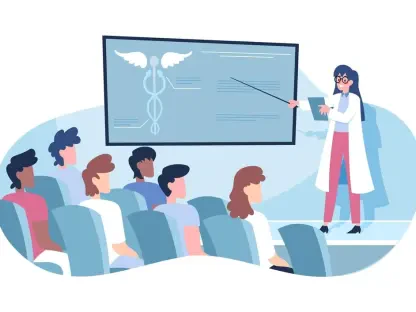As healthcare becomes increasingly digital, both patients and providers expect a seamless integration of connected healthcare technologies such as telehealth, remote patient monitoring, and patient portals. These technologies promise to improve clinical outcomes and manage administrative tasks more efficiently. However, several challenges must be addressed to ensure successful implementation and utilization, particularly regarding patient trust, clinician buy-in, and equitable access.
Addressing Patient and Provider Challenges
Enhancing the Provider-Patient Relationship
Connected healthcare technologies are designed to enhance the provider-patient relationship by increasing touch points and improving data exchange. Despite their benefits, these technologies can disrupt clinician workflows, which necessitates careful consideration and management. Frank Osborn, M.D., chief medical officer of the Tufts Medicine Integrated Network, emphasizes the significant role of culture over strategy when redesigning workflows. He advocates for a physician-led culture to better identify and address the actual pain points in clinician workflows, rather than relying on assumptions made by management. This approach not only aligns with the unique needs of clinicians but also fosters a sense of ownership and responsibility among providers.
Additionally, by fostering a culture that prioritizes physician input, healthcare organizations can create a more cohesive and efficient workflow. This collaborative environment ensures that solutions are grounded in practical experience rather than theoretical ideals. Frank Osborn’s insights underline the necessity of understanding and addressing the nuanced challenges that healthcare professionals face daily. By engaging clinicians actively in the integration process, healthcare systems can mitigate potential disruptions and harness the full potential of connected healthcare technologies.
Phased Technology Integration
Tufts Medicine has adopted a phased technology integration process that allows health systems to address issues as they arise and ensure critical provider buy-in. This approach helps in managing disruptions and facilitates smoother transitions. Lauren Hopkins, MPH, assistant vice president of virtual care and community engagement at WellStar MCG Health, reinforces the importance of gaining early buy-in from physicians to support clinicians effectively. Engaging clinicians in the implementation process and seeking their input can help establish a feedback loop and ensure the success of new technologies.
This phased approach also provides an opportunity to identify and rectify potential issues before they escalate, thus minimizing the risk of significant disruptions. By incorporating feedback from the initial stages of implementation, healthcare organizations can fine-tune their strategies and make necessary adjustments. This iterative process ensures that the integration of new technologies is as seamless as possible, reducing resistance from providers and enhancing overall satisfaction. Hopkins’ emphasis on early buy-in highlights the critical role that clinicians play in shaping the future of healthcare technology.
Building Patient Trust and Digital Health Literacy
Educating Patients on Digital Tools
Anjali Bhagra, M.D., M.B.A., professor of medicine at the Mayo Clinic, highlights the challenge of maintaining patient trust as healthcare systems become more complex and technologically advanced. She stresses the importance of educating patients about the technologies being used, the data collected, and how it will be used to enhance digital health literacy. Educating patients can help alleviate concerns and build trust in the new systems. As patients become more informed about the benefits and functionalities of these digital tools, their willingness to engage with and utilize these technologies increases.
Furthermore, providing clear and accessible information about the use of digital health tools can empower patients to take an active role in their healthcare. Understanding how these technologies work and how their data is handled can demystify the process, fostering a sense of security and participation. By proactively addressing patient concerns and questions, healthcare providers can facilitate a smoother transition to digital health platforms. This educational approach not only enhances patient trust but also promotes a more integrated and effective healthcare experience, bridging the gap between providers and patients in the digital age.
Establishing a Feedback Loop
Engaging patients in the technology integration process is crucial. By seeking patient feedback and addressing their concerns, healthcare providers can ensure that the technologies are user-friendly and meet patient needs. This feedback loop can also help in identifying potential issues early on and making necessary adjustments to improve the overall patient experience. Involving patients in the evaluation and refinement of digital health tools ensures that these technologies are tailored to their preferences and requirements. This collaborative approach strengthens the relationship between providers and patients and secures the successful adoption of new health technologies.
Moreover, a robust feedback mechanism allows healthcare organizations to continuously monitor the effectiveness of their digital tools and make iterative improvements. This adaptive strategy not only aligns with the dynamic nature of healthcare but also reflects a commitment to patient-centered care. By prioritizing patient input, providers can cultivate a more inclusive and responsive healthcare environment. Establishing a feedback loop thus becomes a key element in the broader strategy of integrating connected healthcare technologies, ensuring that both patients and providers benefit from these advancements.
Long-Term Strategy in Technology Integration
Cognitive Flexibility and Adaptability
Bhagra points out that healthcare is rapidly evolving, and maintaining cognitive flexibility and adaptability within workflows is crucial. As workflows established today may become obsolete in a few months, healthcare organizations must remain open to change and build wide-ranging partnerships. This adaptability ensures that healthcare providers can keep up with technological advancements and continue to provide high-quality care. Remaining agile in the face of constant change allows healthcare systems to pivot quickly and integrate emerging technologies that can further enhance patient outcomes.
Moreover, adopting a mindset that embraces continuous learning and innovation encourages a culture of improvement within healthcare organizations. This proactive approach not only addresses immediate challenges but also anticipates future needs. By fostering an environment that values cognitive flexibility, healthcare providers can stay ahead of industry trends and maintain a competitive edge. This ongoing commitment to adaptability ensures that healthcare systems remain responsive to both technological advancements and patient needs, ultimately leading to more effective and sustainable solutions.
Building Wide-Ranging Partnerships
Healthcare organizations must collaborate with various stakeholders, including technology providers, community organizations, and other healthcare entities, to ensure a comprehensive approach to technology integration. These partnerships can help in addressing the diverse needs of patients and providers, ensuring that the technologies are effective and accessible to all. Leveraging the expertise and resources of multiple stakeholders can provide a more holistic and inclusive implementation strategy. Wide-ranging partnerships are essential to addressing the varied determinants of health, providing a more robust support system for patients and enhancing overall healthcare delivery.
Additionally, these collaborations can help in identifying and overcoming barriers to adoption, such as technological literacy and socioeconomic constraints. By working together, stakeholders can develop targeted interventions that address specific community needs and improve access to connected healthcare technologies. This cooperative approach can result in more equitable and sustainable healthcare solutions. Building strong alliances with a diverse range of partners ensures that healthcare technology integration is not only feasible but also impactful, leading to better health outcomes for all patients.
Ensuring Equitable Access to Connected Healthcare Technologies
Providing Technical Support
Ensuring equitable access to connected healthcare technologies is a critical aspect emphasized in the article. Without focusing on access, healthcare providers risk inadvertently widening existing health inequities. For example, if patients do not understand how to use digital health tools, the benefits of these tools will not be realized. At Mount Sinai Health System, a digital engagement team provides critical technical support to patients, helping them understand and use the digital tools available. This support is essential in bridging the gap between technological advancements and patient utilization, ensuring that all patients can benefit from digital healthcare solutions.
Furthermore, providing comprehensive technical support services can significantly enhance patient confidence and engagement with digital health tools. Mount Sinai’s approach underscores the importance of user education and assistance in promoting the effective use of these technologies. By offering guidance and troubleshooting assistance, the digital engagement team enables patients to navigate the complexities of digital health systems with ease. This hands-on support ensures that technological innovations translate into tangible health benefits, highlighting the necessity of integrating human assistance with digital solutions.
Balancing Human and Technology-Centric Workflows
The health system also partners with third-party service providers to assist patients in setting up and using remote patient monitoring tools at home. Eric Kim, senior director of digital experience at Mount Sinai, notes that while technology is essential, human support remains indispensable, particularly when addressing economic constraints and achieving a balance between human and technology-centric workflows. This dual approach ensures that patients receive the necessary technical assistance while also benefiting from personalized care and attention. Balancing human support with technological advancements is critical for delivering a seamless and effective healthcare experience.
Moreover, maintaining a synergy between human and technology-driven components can enhance the overall quality of care. By integrating technological tools with personalized interactions, healthcare providers can offer a more comprehensive and empathetic approach to patient care. This balance ensures that the human element, which is crucial for building trust and understanding, is not lost in the digital transition. The combined efforts of technological innovations and human support can create a more holistic healthcare experience, addressing both clinical needs and patient well-being effectively.
Addressing Social Determinants of Health (SDOH)
Involving Community-Based Organizations (CBOs)
Support for patients facing social determinants of health (SDOH) challenges also extends beyond the healthcare system. Arianne D. Dowdell, vice president and chief diversity, equity, and inclusion officer at Houston Methodist, emphasizes the importance of involving community-based organizations (CBOs) in health equity efforts. CBOs, such as libraries and churches, can help tailor outreach and healthcare resources to engage communities effectively. By leveraging local organizations’ reach and influence, healthcare providers can ensure that initiatives are culturally relevant and accessible. This collaborative effort enhances the effectiveness of interventions and ensures that healthcare services are responsive to community needs.
Additionally, involving CBOs in health equity initiatives can facilitate greater trust and participation from community members. These organizations often have deep-rooted connections and understanding of the populations they serve, making them ideal partners for outreach and education efforts. By working closely with CBOs, healthcare providers can navigate cultural and social barriers more effectively and deliver more targeted and impactful healthcare solutions. Dowdell’s insights highlight the necessity of a multifaceted approach to addressing SDOH, emphasizing the role of collaboration in achieving health equity.
Tailoring Outreach and Resources
Dowdell underscores that a one-size-fits-all approach is not viable, and healthcare providers must collaborate with various entities to address the unique needs of different populations. For over 30 years, Houston Methodist has invested in and partnered with CBOs to connect patients with resources that can help them overcome SDOH barriers. This collaborative approach ensures that healthcare resources are accessible and relevant to the communities they serve. By tailoring outreach efforts and providing customized support, healthcare providers can more effectively address the specific challenges faced by diverse populations.
Moreover, consistent engagement with CBOs enables healthcare systems to stay informed about evolving community needs and adapt their strategies accordingly. This continuous feedback loop fosters a more dynamic and responsive healthcare model that can address social and health disparities more effectively. Tailoring resources and outreach to meet community-specific needs not only enhances the reach and impact of healthcare initiatives but also builds stronger, trust-based relationships with the populations served. This targeted approach is crucial for promoting health equity and ensuring that all patients have access to the resources they need for optimal health.
Progress Toward Health Equity
Commitment to Equity
As healthcare increasingly adopts digital technology, both patients and providers anticipate a smooth integration of connected health solutions like telehealth, remote patient monitoring, and patient portals. These tools hold the promise of enhancing clinical outcomes and streamlining administrative responsibilities. For instance, telehealth allows for remote consultations, saving time and resources for both patients and healthcare professionals. Remote patient monitoring can continuously track patients’ health status, enabling timely interventions and reducing hospital readmissions. Patient portals give patients direct access to their health records, making it easier for them to stay informed and engaged in their care.
However, several challenges are critical to address to ensure these technologies reach their full potential. Building patient trust is paramount, as concerns about data privacy and the reliability of digital interactions can hinder adoption. Equally important is gaining clinician buy-in, as healthcare professionals need to be convinced of the efficacy and user-friendliness of these tools to integrate them into their practice fully. Additionally, ensuring equitable access to these technologies is crucial. Not all patients have the same level of access to digital tools, which can exacerbate existing healthcare disparities. Overcoming these hurdles is essential for the successful implementation and utilization of digital healthcare solutions.









